Distinguished guests, ladies and gentleman,
I am very pleased to be in Washington today addressing you. As some of you may know, at the end of last year I spent time reflecting on the challenges that so many women have faced over the years in order to bring forward an innovative solution. Last May, I wrote a white paper about that proposed solution and I am here today to speak to you about it. It is a business approach to business challenges.
I'd like to begin with a true story about an African American man named Chris Gardner, Some of you may have seen this story. I'll summarize it briefly because it speaks very simply to the heart of the matter I'm addressing. Chris Gardner went from spending a brief time homeless with a child, living in the toilet of an underground metro, to becoming a successful owner of a brokerage firm.
Today, Chris Gardner recounts the following story when conducting mentoring sessions with high school students. His first job selling stock was selling over the phone. His customers would inevitably tell him the latest politically incorrect jokes and socially abhorrent stories. He would listen, swallow the response he really wanted to give, and 'sell those shares'. Two years later, one of his customers, who had been particularly rude with jokes, showed up at the office to thank Chris Gardner because he had made so much money for the customer. As Mr. Gardner made his way to the conference room to meet the customer he resigned himself to the fact that he would probably lose the customer when he discovered Mr. Gardner to be African American.
Quite to the contrary, the customer remained Mr. Gardner's customer for 20 years, until the day the customer died. Chris Gardner enthusiastically points out to the students that American business only knows one color - the color of money.
Unfortunately, today women don't necessarily benefit from that reality. Because when a woman gets on the phone, the person on the other end generally can ascertain that it is indeed a woman. There is however a different method for us to benefit from the same principle.
In the Gardner story, there was a direct visible link between the financial results he produced and his customer's bank account. To the client it made sound business sense to stay with Gardner because it was glaringly obvious to the customer that he was making money.
Why am I telling this story? Because, for all we women have accomplished, most public corporations and institutional investors address agendas related to women based on social responsibility not on the profits women make for them. Particularly noteworthy is the fact that women themselves have only pushed for women friendly policies based on social responsibility.
I am not trying to suggest that we cease using corporate social responsibility agendas but rather that we add the use of business techniques to address business. For all the business acumen we women possess and apply to our businesses, we have not yet applied business methodology to achieving any of the core requirements: equal wages, more decision-making positions, and more directors on boards in publicly traded corporations.
-
On one hand, we are confident that women at multiple levels of participation make an equal contribution to that made by men to the value of corporate shares
-
On the other hand, women have sponsored limited research to prove this as fact.
We remain locked in a struggle to achieve equal pay for our equal or sometimes superior contributions. We continue to 'demand rights', which we 'deserve' . This has worked to the degree that it has, although with a certain backlash. The point is that we can go beyond this.
I propose that the value placed on women's productivity can only be recognized and given equal value with male productivity - when it is demonstrated that some women friendly policies and related issues impact the value of corporate shares. With a business approach to these issues, success could be achieved.
The purpose of this presentation today is to lay out that business approach to achieve some of these goals and to obtain your support for this initiative.
What is it that makes this point in time different for women?
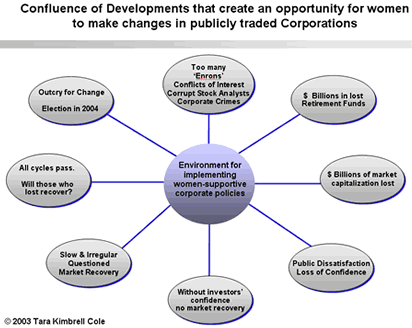
Let's move clock wise around this slide.
From Enron and Anderson to crooked analysis rigged to sell certain stocks, greed and lack of ethical conduct have indeed sacrificed the collective well being.
Retirements of hundreds of millions of working people have been lost along with the opportunity for a broad sharing in the abundance created by a robust share market. Billions of Dollars in market capitalization have been wiped out There has been loss of confidence by a broad base of investors in the market, with out which a robust share market can not recur. There has been a slow, irregular, still questioned recovery. Of course, this market cycle will pass, but will all those families that were working for their retirements or lost their retirements be compensated in their lifetimes? It is unlikely. All have created public dissatisfaction and outcry for change and the presidential election looms. There appears to be some willingness to reflect and some consideration of new solutions.
One such solution may be to create a balance in corporate leadership and governance. There is the possibility that women could bring that balance and be part of the market solution by taking a greater place in leadership.
How can women take advantage of the times to accomplish these goals?
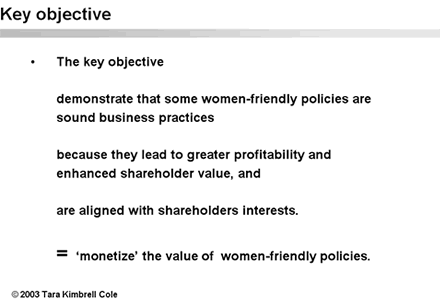
The key objective is to demonstrate that some women friendly policies are sound business practices because they lead to greater profitability and enhanced shareholder value, and are aligned with shareholders' interests. This will drive a strong alliance between women friendly policies and the shareholders. The result will ‘monetize’ the value of women friendly policies.
Research must be completed in order to identify the specific policies. Then it must be demonstrated through work with the rating agencies that the issues surrounding those policies (or the lack thereof) directly impact investors' perception of risk. This impact on the perception of risk affects the value of the shares and the corporation's cost of capital. I'll demonstrate how this works in a few minutes with diagrams and examples.
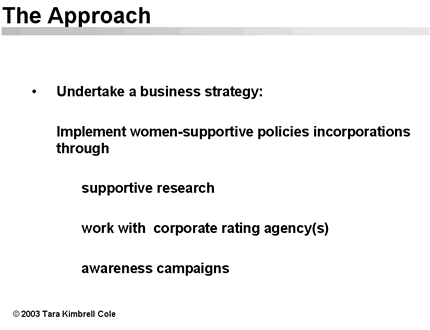
The approach is to undertake a business strategy:
To implement identified women supportive policies in corporations through
-
research that is supportive
-
work with corporate rating agency(s)
-
awareness campaigns
While I recognize that the results of research must be known and that those results may uncover new issues, the goal is to drive the following changes along with others yet to be uncovered:
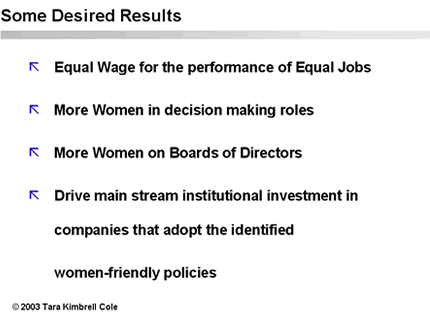
Equal Wage for the performance of Equal Jobs
-
More Women in decision making roles
-
More Women on Boards of Directors
-
Better working conditions for women at multiple levels of corporations
-
More institutional investment specifically in corporations that have adopted women friendly policies because of the proven impact on share value
Through 'monetizing' the value of these women friendly policies we will strengthen women's economic and security rights.
There have been some encouraging research results and announcements of research underway.
IN May 2002, Conference Board of Canada, Canada's leading research organization, indicated in a research report that there appeared to be an alignment between the drive for good corporate governance and the drive for more women on boards (diversity) and in decision-making positions. The study indicated that Boards with more women are more likely to consider measures of innovation.
'Undertaking the research' is an idea whosetime has come. There appear to be parallel developments where the research is concerned. Catlayst, the Canadian women' research group has worked, to date, mainly to raise political and moral arguments against discrimination. Ms. Ilene Lang, the new President, has recently announced that the next step for Catalyst is to make the business case for gender diversity. Her new mission as President is to prove to corporations that more women in the executive suite and on the board help increase profits. By the end of the year, Catalyst will release a major report that shows the link between having women on boards and in top executive positions, and posting a strong corporate performance.
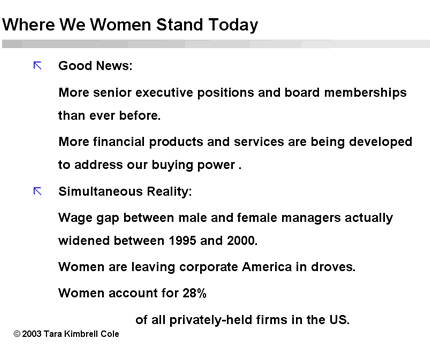
Let's review our progress in the corporate world today:
The good news:
-
We have more senior executive positions and board memberships than ever before.
-
More financial products and services are being developed to address our overall buying power.
-
We are fully recognized as a consumer class
-
In 2002, 15.4% of fortune 500 board seats held by women (catalyst) By way of comparison, in 2001, European companies had less than 6% women and in Canadian companies, 9.8%.
But the simultaneous reality is:
-
The wage gap between male and female managers actually widened between 1995 and 2000. For example, one set of statistics indicates that
-
in the communications industry in 2001, a woman earned 73 cents for every $1 a man takes home.(10)
-
Five years earlier a woman made 86 cents for every $1 a man took home.
-
Only 4% of the top earners at Fortune 500 companies are women.(10) When women have held executive positions, they were more often in management jobs, which have lower power.
-
In 2001, Women filled only 7.3% of the total line positions held by corporate officers.
-
The widest pay gap is between parents. Fathers make more than mothers.
-
In the past 10 years, the percentage of business-school applicants who are women has not risen at all. It has remained at around 38%.
Other current trends:
-
Women are leaving corporate America in droves.
-
Many of the most qualified women in the younger generation have no patience for the compromises that older generations of women executives have made to participate in the corporate world. If the big corporations don't want to give them equal wage and opportunity, it is their loss. These women will make their own opportunities elsewhere.
-
As of 2002, estimated 6.2 million privately held women-owned firms in the US, representing 28% of all privately held firms in the US.
-
Between 1997-2002, women-owned businesses in the US increased by 14% and the sales from these businesses increased by 40%.
The growth of women entrepreneurs in and of itself is an important & positive development.

The Younger generation of women seek work environments that
-
value individuals - whether as customers or as employees
-
are transparent and collaborative
-
value what's ethical above what's expedient.
It is important that not all of these young women completely leave the corporate world, some need to stay to influence it. Indeed, we need some of these women just because of these value sets. As well, not all women's talents may be best realised and or their contributions best delivered via an entrepreneurial context. Also corporations need to tap the wisdom of ‘’battle-ready’’ senior women executives as they rebuild from the current financial markets' disaster.
The departure of women from corporate life will leave society even more vulnerable to decisions by corporations unchecked by the balance created from women in their leadership ranks.
An example may be seen in CNN Lou Dobb's choice of 'CEO for the week' of May 3, 2003 - during what appeared to be at the time, the height of the corruption scandals. It was a co-chief executive 'officer-ship' held by Herbert M Sandler and Marion O. Sandler, the Co-CEOs of Golden West Financial Corporation (www.worldsavings.com). Golden West Financial Corporation ('Golden West') is one of only two Fortune 500 companies with a majority of women directors on their board. Golden West has produced continuous stellar financial performance throughout the last 5 years despite the market's chaos.
Can the company's performance be separated from the underpinnings of its corporate governance and conduct? Most believe not and this research is now underway, it is the part that women friendly policies play in this process that needs to be the focus of the new research.
The time is right to complete all the necessary research that could prove the impact of women's work directly on share value. I suspect that research on some of the issues may turn out similar to the research on heart disease. That research initially indicated women weren't affected. But then we discovered they had never studied women! We all now know the results indicated that indeed women have just as much of a inclination towards heart disease.
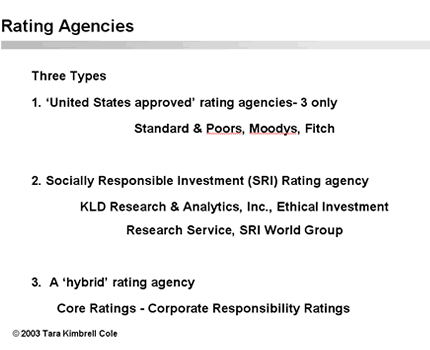
Let's examine the rating agencies and their impact on the markets.
There are basically 3 types of rating agencies. 1. There are 3 US approved corporate rating agencies by Nationally Recognized Statistical Rating Organization (NRSRO), Standard & Poors, Moodys and Fitch. The ratings that these companies ascribe to corporations drive share prices via their impact -most importantly- on institutional investors, stock analysts and investment advisors.
Influencing institutional investment is the key to success.
1. The NRSRO agencies focuses on issues that affect
-
Share Value
-
Profitability
-
Investors Risk exposure with regard to the two aforementioned
-
All and only issues that drive the value of the shares
Example: The history of the asbestos companies, the disregard of the NSRSO agencies, the subsequent class actions and final results.
2. The SRI Rating agencies focus on issues that affect
-
Corporate social responsibility
-
Corporate Earnings
Earnings do not necessarily impact the value of the shares. Their biggest Challenge is that of ‘preaching to the choir’. They have not been heard by the mainstream because they are speaking a different language.
3. One rating agency (owned by Fitch), Core Ratings, works on a hybrid of the two models. They have made progress in furthering the adoption of socially responsible policies (with respect to the environment and some other SR issues), when the issues related to those policies (or the lack thereof) have directly impacted Investor's perception of risk, which in turn affected the corporations share value and cost of capital.
One important difference is that Core Ratings identifies the problem earlier in the cycle, evaluates the investor risk up front and drives a result long before the Class action stage. This is an example of the proposed method to drive women friendly policies.
Example: the process utilized with a chemical company that was dumping waste in an adjacent river.
We've made progress with the social responsibility model, but is the progress we've made enough? I suspect that most you in this room think it is not.
We are all familiar with how the social responsibility model works, so I'll only review it briefly for comparison purposes with the proposed business approach model.
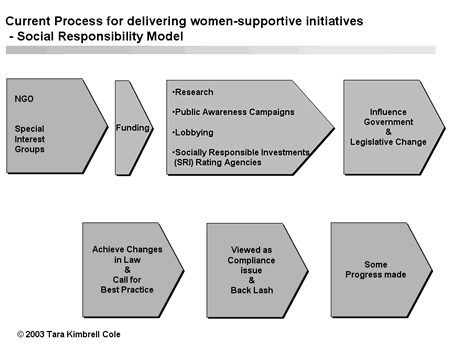
(Reviewed)
An example of the back lash, years ago we began to see token women on boards, while we all watched the glass in the ceiling thicken.
In 2001, the reality was that only 3% +/- of all funds invested are in Socially Responsible
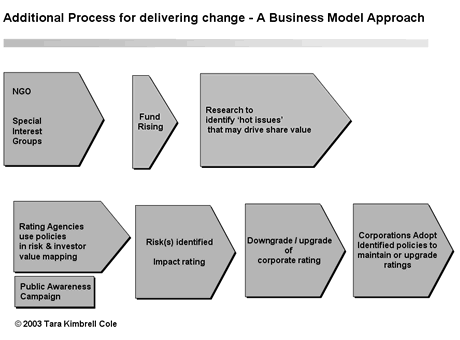
(Reviewed along with examples of the proposed model's potential results with regard to institutional investment allocation and rating categories.)
If research could show that the stock performance of companies with a balance of men & women board directors fared better during the last downturn, this would indeed further the progress toward the identified goals. Hopefully, further research will indicate a positive correlation between stock out performance and the number of women directors in a company.
With regard to the research, while I recognize the complexity of the issues and have the greatest of respect for research, I also recognize that completing all the research humanly possible does not necessarily assure any changes in the reality women face. Identifying specific issues that have the potential to drive results, doing the research on those issues and using that specific research result as a business tool to drive & manage change is the focus required. The specific issues for research must be chosen mindfully. Public communication about research that does support the impact of policies and their related issues must be managed effectively. This also must include careful structuring of the research and the choosing of the methodology to be applied.
When situations resulting from the lack of specific policies can be shown to have impact on the value of the shares, these must be moved forward into investor consciousness and utilized to impact the perceived risk to the share holders' value. Then the goal is to work closely with a rating company, such as Core Ratings, to call attention to each identified perceived risk to the value of shares.
It's worth noting that there already is substantial literature on compensation and the circumstances under which it makes sense to tie it to shareholder value, although it does not specifically address the performance of women executives. (Web site of the National Bureau of Economic Research).
Closing Summary
It’s time for businesswomen to move themselves beyond the corporate responsibility category on the balance sheet, to use business 'know how', tactics and methodology to drive progress on these outstanding issues.
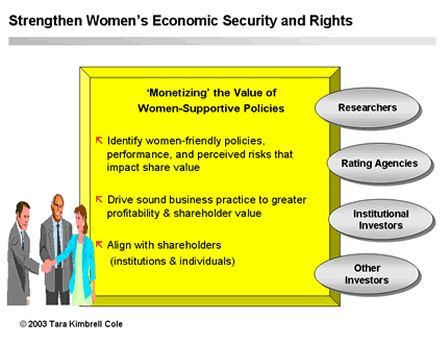
This can be achieved by demonstrating through research and work with a corporate rating agency(s) that some women friendly policies must be seen as sound business practice because they lead to greater profitability and enhanced shareholder value. They are aligned with shareholder interests and thereby their absence can create risk for the investors.
Moving forward, we need to
-
Raise funds through multiple organizations for research not already being conducted by Catalyst.
-
Engage a project implementation plan. In the last few months in the process of answering questions about the paper, I have prepared a project plan that addresses among other issues the management of the coordination between the research, rating agency(s) & public awareness campaigns
There are still many questions to be answered such as, would it be better for certain aspects of research to be completed by female neutral research companies such McKinsey or Accenture? But answers there are.
So just as Chris Gardner showed his customer, we women need to make glaringly obvious the specific connections between women friendly policies / performance, increased profits and the increased value of the shares in investors' pockets.
Thank you for your interest and consideration.
I'd be happy to take your questions.
The contents are not to be cited or reproduced in any form without prior and explicit permission of the author. Views expressed herein are entirely those of the author.
Copyright © 2003 Tara Kimbrell Cole
Let us know how we can help you.
